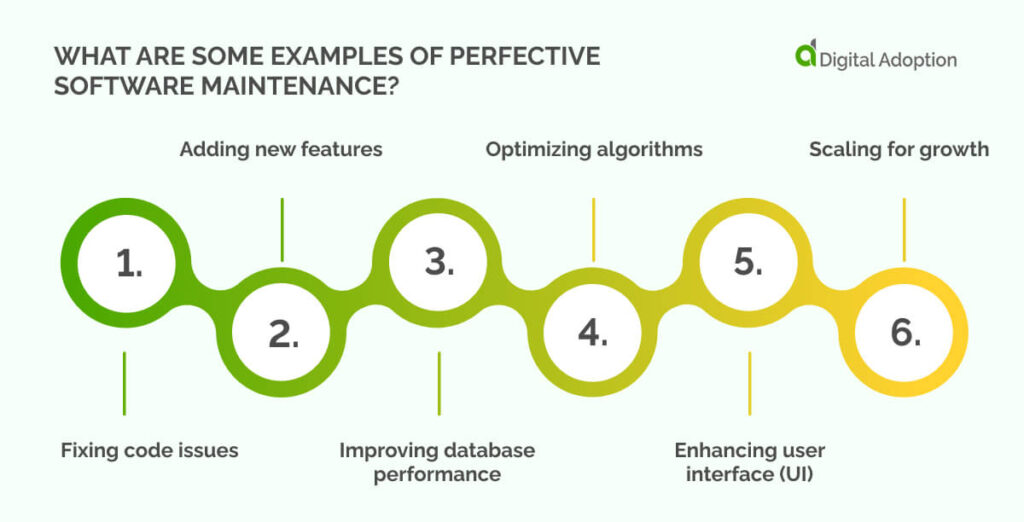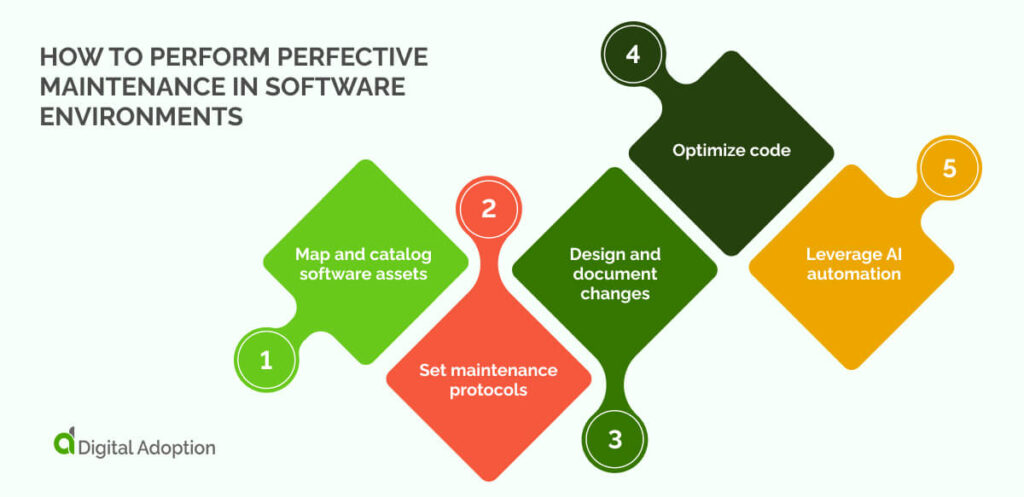The digital transformation wave has sparked innovation across industries.
Advances in cloud computing, blockchain, and artificial intelligence (AI) adoption are reimagining traditional business processes.
Software-as-a-Service (SaaS), the Internet of Things (IoT), and other technologies like 5G and edge computing must be responsive and perform at their best.
These software-connected technologies rely on integrations and constant updates to function. System breaches and downtime can hurt businesses if maintenance isn’t done regularly.
Luckily, perfective maintenance ensures quality and reliability for enterprise assets. It acts as a safety net, minimizing inefficiencies and driving ongoing improvements.
This article explores perfective maintenance. We’ll look at what it is, how it works, and best practices for teams when making changes.
- What is perfective software maintenance?
- How does perfective software maintenance work?
- How is AI used in perfective software maintenance?
- What are some examples of perfective software maintenance?
- What is the difference between perfective maintenance and corrective maintenance?
- How to perform perfective maintenance in software environments
- A future outlook on perfective maintenance
- People Also Ask
What is perfective software maintenance?
Perfective software maintenance is the process of modifying software functions to improve usability and reliability in response to evolving user requirements.
It typically includes the implementation of new features and system upgrades that optimize performance.
Perfective maintenance actions may involve streamlining code, system reconfigurations, algorithmic changes, or software and hardware updates.
This maintenance type is usually triggered after service delivery, as modifications are based on users’ evolving needs and interactions with the product.
Perfective maintenance forms part of a broader maintenance management strategy aimed at enhancing enterprise asset quality and assurance.
Advancements in AI and machine learning are also transforming maintenance management strategies, with perfective maintenance being no exception. These technologies enable the analysis of system data to identify patterns and predict future adjustment needs, further optimizing maintenance efforts.
How does perfective software maintenance work?
Perfective maintenance in software focuses on system optimization, not just fixing faults. Unlike reactive maintenance, which deals with urgent issues, perfective maintenance is planned and intentional.
It ensures that software remains efficient and meets user needs throughout its lifespan.
Perfective methods rely on user feedback and performance metrics. These help maintenance teams identify areas where improvements can boost performance.
Developers perform code reviews to spot redundancies and simplify complex structures. They may then update algorithms to handle data more effectively or redesign certain functions to ensure smooth workflows.
Hardware compatibility updates are also common. These updates keep software responsive to new devices and specifications. Perfective maintenance testing is thorough.
It checks new features and how these changes interact with existing components. Each update undergoes compatibility tests to ensure the software remains stable.
How is AI used in perfective software maintenance?
Like other maintenance methods, perfective maintenance is set to be positively impacted by advances in AI.
Manual adjustments and scheduled reviews have long made perfective maintenance static. Current methods are not agile enough to keep up with the complexity of modern operations.
AI looks to bridge the gap, offering solutions that blur the line between perfective and predictive methods.
AI can ingest both user and platform data to reveal potential improvement areas often undetectable to the human eye. It uses ML to monitor user behavior and learn how users interact with the UI and what may be dampening experiences.
AI’s predictive capabilities can also anticipate future demands or pain points. They detect patterns and make forecasts based on historical and current system data. This allows maintenance teams to refine and mitigate problems before they become reactive concerns.
Elsewhere, natural language processing (NLP) techniques can read unstructured data, gleaning a host of user information from various sources. AI can glean review sites, social media, ticket requests, and community forums to anticipate future user needs. This gives maintenance teams a head start at implementing changes before they’re needed.
Hyperautomation is another strength of AI. Time-intensive code reviews and refactoring eat away at technicians’ time, which they could spend focusing on more high-value tasks. Now, AI can assess, refactor, and update code automatically—in real-time.
AI’s high-octane automation also extends to continuous database monitoring, testing, regression analysis, and feature usage, to name a few.
What are some examples of perfective software maintenance?

We’ve explored how perfective maintenance in software works, compared with different techniques, and its connection with AI.
Now, let’s look at some key examples of perfective methods in action.
Fixing code issues
This is more than just fixing bugs. Developers may want to improve the efficiency of existing code. For example, they can optimize loops or refactor functions to speed up execution.
Reducing HTTP requests in a web app can also reduce loading time. Removing unused code and redundant functions streamlines the system, improving its performance.
Adding new features
User feedback often calls for new features. For instance, adding a dark mode option in apps can improve user experience.
Integrating third-party services like Google Pay or Apple Pay in an eCommerce app offers more payment options. Adding features like real-time notifications or search filters makes the app more useful without changing its core purpose.
Improving database performance
Optimizing a database is a common part of perfective maintenance. This can include indexing columns that users frequently search or rewriting complex queries. Making these adjustments reduces response times.
Updating the database schema to normalize data can also improve speed and reliability. For example, indexed lookups instead of full table scans speed up data retrieval in busy environments.
Optimizing algorithms
Reworking algorithms improve efficiency. For example, replacing a bubble sort with a quicksort algorithm can speed up sorting processes. Using a more efficient method like gradient boosting can yield better predictions in ML.
Implementing caching mechanisms like LRU (Least Recently Used) can reduce server load and speed up response times for web applications.
Enhancing user interface (UI)
UI updates improve user experience. For example, developers might reorganize button layouts to make them easier to use. Updating color schemes for better visibility or simplifying navigation menus can make the interface more user-friendly.
Switching from a hamburger menu to a bottom navigation bar can make apps easier to navigate on mobile devices. Adding touch-friendly controls or scalable graphics can also help the app perform well on different devices.
Scaling for growth
Software often needs changes to handle more users. Moving from a monolithic architecture to microservices can help. Each component can be scaled independently based on demand. Load balancing and database sharding are common practices to manage increased traffic.
Auto-scaling can adjust resources to match traffic spikes in cloud environments, preventing downtime. Reducing tasks that use a lot of resources during peak hours can also help maintain performance and increase cloud transformation.
What is the difference between perfective maintenance and corrective maintenance?
Perfective tasks involve optimizing software functions based on shifting user demands.
Corrective maintenance, on the other hand, concerns fixing software faults before or after an issue occurs.
Both are key maintenance management strategies, but each takes a different approach. Discover more on how they differ in the chart below:
| Aspect | Perfective Maintenance | Corrective Maintenance |
| Trigger | Initiated by feedback or performance analysis to improve functionality | Triggered after faults, errors, or bugs are identified |
| Timing | Planned and scheduled to refine and upgrade the system | Immediate response to address malfunctions |
| Objective | Focuses on enhancing usability, efficiency, and user satisfaction | Resolves faults and returns software to proper working order |
| Scope of Work | Modifications to improve structure, add features, or optimize code | Fixes errors, malfunctions, and broken functions |
| Impact on Codebase | May involve refactoring, restructuring, or adding features | Repairs specific areas without broad changes to code structure |
| Testing | Extensive testing for integration and performance improvements | Focused testing to verify issues are resolved |
| User-centric Changes | Incorporates evolving user needs, focusing on long-term satisfaction | Addresses immediate user issues caused by bugs or errors |
| Cost Implications | Planned updates reduce the need for major overhauls | Reactive, often leading to higher costs due to unscheduled fixes |
| Risk of Disruption | Lower, as updates are planned and tested for smooth integration | Higher, as unforeseen errors can disrupt the software |
| Monitoring Requirement | Periodic review for opportunities to optimize and upgrade | Reactive to errors; does not require continuous monitoring |
How to perform perfective maintenance in software environments

When changes and updates to software are needed, teams must know how to step into action and perform perfect tasks efficiently.
Here’s how to perform perfective maintenance in software environments:
Map and catalog software assets
First, list all parts of the software. This includes modules, APIs, databases, and libraries. Note their functions and how they connect. A full inventory helps ascertain which areas need improvement and clearly tracks changes.
Set maintenance protocols
Create rules for updating the software, define coding standards and testing steps, and use tools like Git for version control to track changes. Teams will also need to plan the deployment process. Consistent guidelines underpin maintenance principles and minimize mistakes.
Design and document changes
Before making updates, plan carefully. Check user feedback and performance data to find weak points. Write a change proposal with clear goals, affected parts, and expected results. Document every detail so the team understands the updates.
Optimize code
Review the current code to find issues. Refactor to remove unnecessary parts and improve clarity. For instance, replace slow algorithms with faster ones. Reduce extra database calls to speed up responses. These tweaks make the software more efficient.
Leverage AI automation
As we know, AI can augment many maintenance functions. ML models find parts of the software that need work based on usage patterns. Automated code review tools can check for errors or inefficiencies. These tools expedite maintenance and let teams refocus their efforts on more meaningful tasks.
A future outlook on perfective maintenance
So, what’s all the fuss about maintenance management? The move towards digital adoption solutions means businesses rely on technology for critical operations.
Technology has never been so important in helping companies move faster and succeed. Undoubtedly spurred on by sector-wide digital transformation, asset quality and reliability have now become a must.
To maintain speed, businesses need software that performs at its best and mitigates causes of downtime.
Perfective maintenance is just one of several maintenance management methods working in tandem to achieve this.
People Also Ask
-
Can perfective maintenance disrupt software performance?Perfective maintenance can cause brief disruptions. Updates and changes may introduce bugs or require system restarts. Careful testing and staging can reduce these risks and keep the software running smoothly.
-
How frequently should perfective maintenance be done?Perfective maintenance should be done regularly but not too often. The frequency depends on the software. For complex systems, it may be needed every few months. Simpler software may only need updates once or twice a year.
-
Will perfective maintenance eliminate all breakdowns?No, perfective maintenance won’t stop all breakdowns. It improves performance and fixes issues, but some problems, like hardware failures or unexpected traffic spikes, can still occur. Combining perfective maintenance with other methods, like corrective or preventive, helps keep the software stable.













